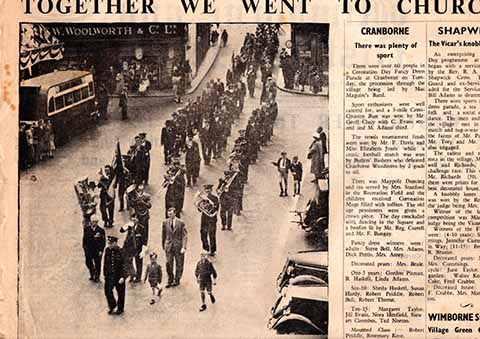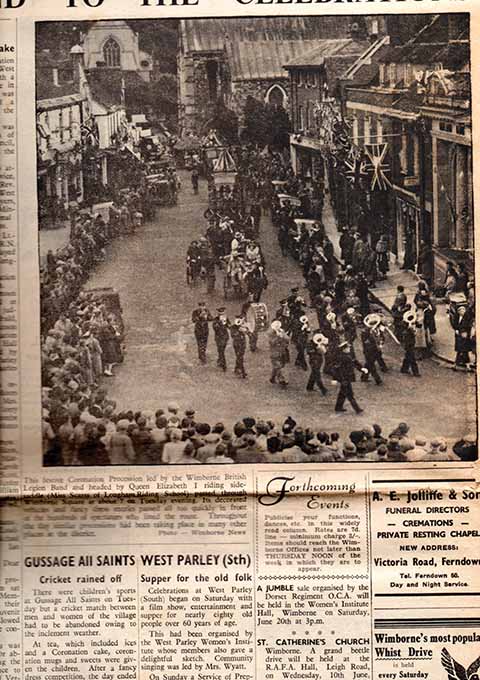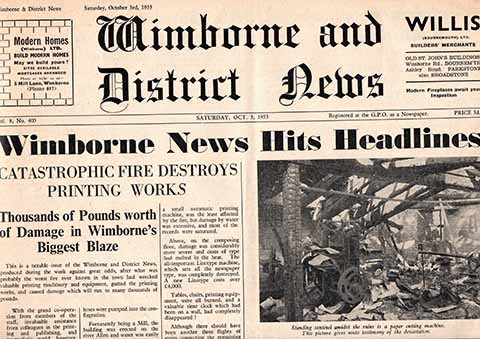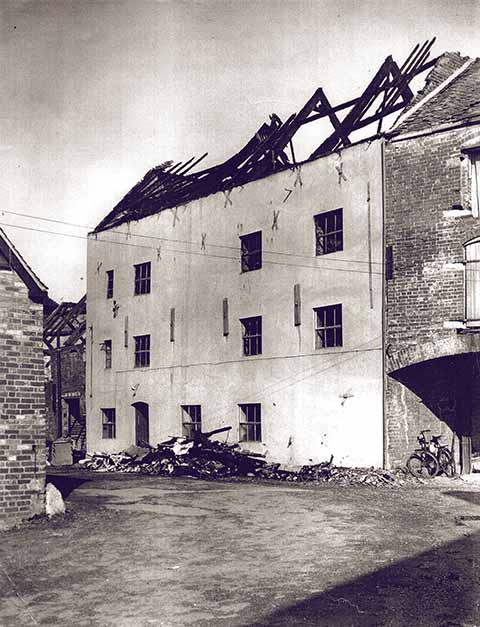Read all about it
Roger Guttridge examines the history of the newspapers in Wimborne
Published in July ’19
On the very day that Wimborne’s last weekly newspaper announced its imminent demise last year, I was coincidentally presented with a bundle of other papers dating back to the early 1950s. The closure of the Stour and Avon Magazine in December 2018 ended seventy years of dedicated Wimborne coverage by various weekly papers. The first of these was the Wimborne and District News and the bundle of newspapers, found in a Wimborne attic, included several early 1950s editions of that paper.
On Saturday 6 June 1953, the Wimborne News marked the Coronation of Queen Elizabeth II with a rare use of spot colour on the front page. The paper also devoted four inside pages to the celebrations in Wimborne and surrounding villages. At the Minster church, ringers rang a full peal of bells and representatives of every church in Wimborne, Colehill and Pamphill attended a United Thanksgiving Service. Miss Scarss of Longham Riding Stables played the part of the Queen as a carnival procession wended its way through Wimborne town centre. Other events included children’s and adults’ sports at Redcotts and tea for 1,500 youngsters, who each received a souvenir mug.

F W Woolworth & Co provides an evocative backdrop as Wimborne’s British Legion Silver Band leads the Coronation Church Parade into the Square on the Sunday before the Coronation
Sports, fancy dress and mug presentations were a feature of celebrations in many towns and villages but there was no shortage of novelty events. At Shapwick, vicar’s wife Mrs Bontoft judged a knobbly knee competition, and named the Rev. Bontoft as the winner! Shapwick’s tallest and shortest men, Mr Boniface and Mr Richards, challenged each other to a running race, with the diminutive Mr Richards (5ft 2in) beating his lanky rival.
Free beer proved a popular attraction at Edmondsham, while at Alderholt, a cricket match between the village’s men and women saw the men using shovels as bats. At Hinton Martell, the village fountain was repainted and restored to working order for the occasion. At Ferndown
and Broadstone, TV sets were provided so that 700 children could enjoy ‘all the gaiety and solemnity of the Coronation Ceremony’ at communal viewings.

Miss Scarss of Longham plays the Queen as the Coronation Day parade makes its way along Wimborne High Street
Not everyone was happy, however. The News printed a letter from reader Betty Rudling, of Uddens Crossing, complaining about the treatment of the under-fives. While older children collected their mugs, the infants were ‘herded together in the pouring rain and bitter wind for over an hour. Three times as we neared the end of the ordeal, the doors were closed and a mad rush across the yard ensued, resulting in the last being first to be served each time,’ she wrote. ‘If the organiser of this unhappy muddle could have heard the crying children and the frustrated, tired mothers, he would not have felt very proud.’
Only four months later came the most memorable issue of the News – a special edition dated Saturday 3 October 1953, whose front page was devoted to a fire that destroyed its own premises. ‘Wimborne News Hits Headlines,’ said the actual headline. ‘Catastrophic fire destroys printing works. Thousands of pounds worth of damage in Wimborne’s biggest blaze.’
The issue included an apology to readers that there were only four broadsheet pages instead of the usual eight ‘owing to fire’. It also included a thank-you message to members of staff and other publishers, printers and journalists, without whose co-operation edition number 405 would not have ‘risen Phoenix-like from the ashes’. Among those mentioned specifically were the Western Gazette and its Wimborne reporter, Doug Henning, who made all their Wimborne news available to their competitor; and Messrs W M Samson of Ashley Road, Parkstone, who overcame ‘considerable inconvenience’ to print edition 405.
The fire was discovered at 1.10 am the previous Wednesday by a passing policeman. ‘We understand that about 20 people called the GPO in a few minutes and soon Wimborne and Poole firemen were on the scene, with the managing director of the firm, Mr Horace L Slocock, who had been called from his home at Hayes, Stapehill,’ reported the paper. ‘The fire, however, had already got a good hold on the building, formerly Wimborne Town Mill, and the intense heat made the firemen’s job extremely difficult.’
The Mill Lane premises dated from about 1750 and were used as a mill until 1925. They then fell into disrepair and lay derelict for some years until renovation work in 1947-48. The Wimborne News itself first appeared on 3 December 1936, when it was printed at Mr Slocock’s home. Publication lapsed during World War 2 and resumed in 1948 after renovation of the old mill.
The fire quickly spread through the four-storey building. The whole place was soon engulfed and ‘tons of water’ were sprayed onto the flames by four hoses. The adjoining River Allen provided a limitless source of water. Four hours passed before the fire brigade were sure the blaze would not spread across an archway to adjoining premises that were used as toy and potato crisp factories. The Poole firemen left at that point but the Wimborne crew stayed on site until 1 pm. Meanwhile, Wimborne News staff arrived for work to be confronted by ‘smouldering ruins’. They immediately set about salvaging as much as possible. A Wimborne clergyman took off his coat and dog-collar to help with the salvage operation.
The front-page report continued: ‘The ground floor, containing an office and printing press and a small automatic printing machine, was the least affected by the fire, but damage by water was extensive, and most of the records were saturated. Above, on the composing floor, damage was considerably more severe and cases of type had melted in the heat. The all-important Linotype machine, which sets all the newspaper type,
was completely destroyed. A new Linotype costs over £4000.
‘Stocks of paper were now nonexistent, records of the life of the newspaper since its inception in 1936 had been destroyed and only charred pieces of metal lying at drunken angles across blackened woodwork showed that there had once been a paper folding machine, stitching machine and paper cutters in the building.’
Copy that had already been set for that week’s paper had ‘turned to liquid lead, and solidified in one hard pool’. Typewritten copy that was ready for setting had also been consumed. The report adds: ‘The Mill was insured against fire and it is expected that new machinery will soon be available. In the meantime we shall continue to accept printing orders, and these will be carried out by an alternative method.’
Horace Slocock’s son, Chris, believes the Wimborne News lasted only a year or so after the fire – although the company continues on the other side of the arch as printers and publishers Minster Press. ‘The insurers never paid out adequately on the building,’ says Chris, now Minster Press’s managing director. ‘But we’re still here as a business and we publish monthly magazines and books. We have adapted to the way things are done these days.’
The 1970s were halcyon days for Wimborne news coverage, with almost every meeting and event covered by at least three reporters – from the Bournemouth Evening Echo, the Western Gazette and the Wimborne and Ferndown Journal – or even four when the Poole and Dorset Herald spread its wings beyond Poole. A news reporter in Wimborne in 2019 is a collector’s item.
The Wimborne and Ferndown Journal was an offshoot of the historic Salisbury Journal series, which in the mid-1950s launched the Southern Journal, covering Wimborne, Blandford and Ringwood. This later morphed into the Wimborne and Ferndown Journal and eventually into the free Avon Advertiser.
Wimborne’s first free paper was The Bugle, launched by Martin and Joan Tidd in 1978. It was the first of many as the dynamics of local newspapers shifted. After selling The Bugle in 1980 to Echo owners Southern Newspapers, who merged it with the Advertiser, the Tidds launched the Wimborne Magazine in 1986 and in 1999 sold that to Trinity Mirror. It then became the Stour and Avon, an offshoot of the Blackmore Vale Magazine. The Stour and Avon’s demise has left a vacuum in Wimborne and it will be interesting to see how it is filled.




